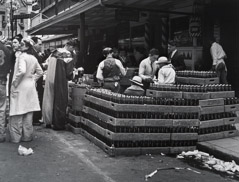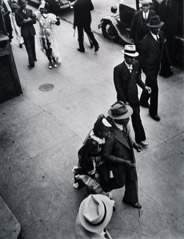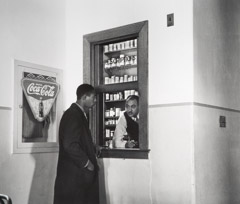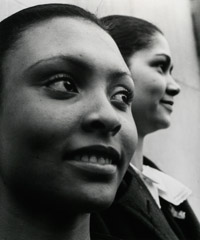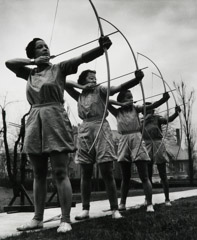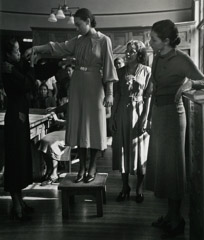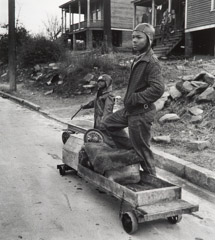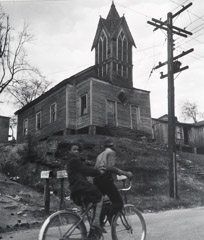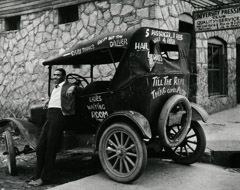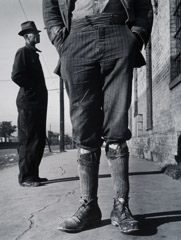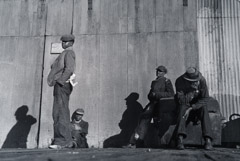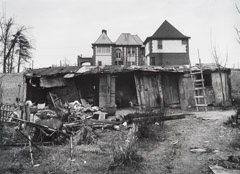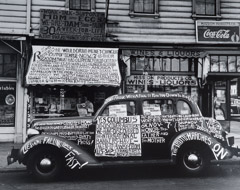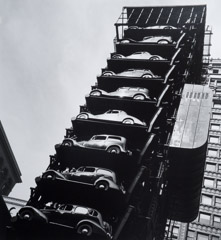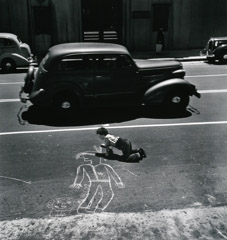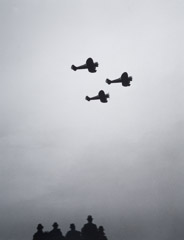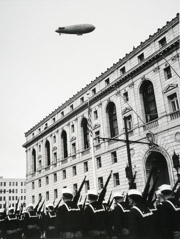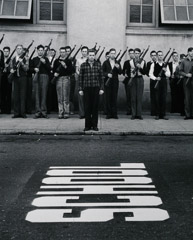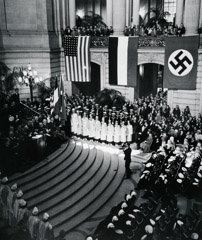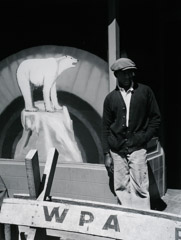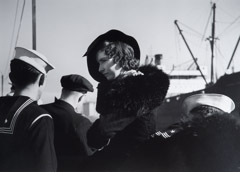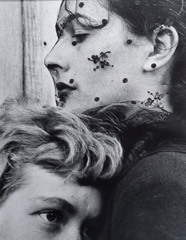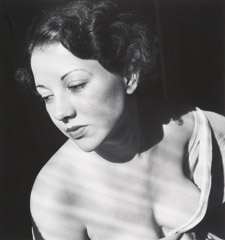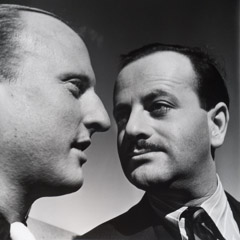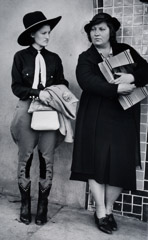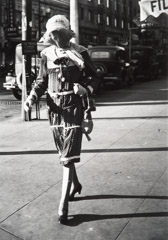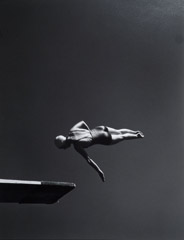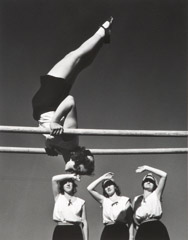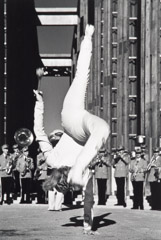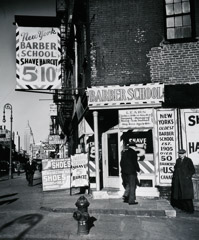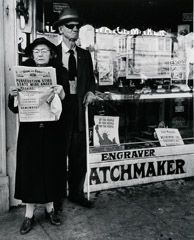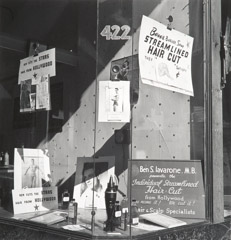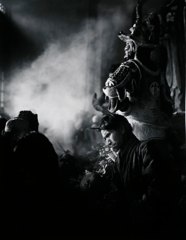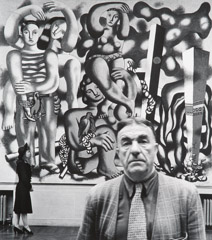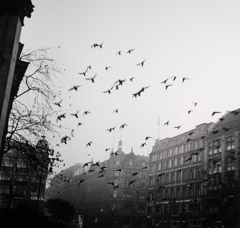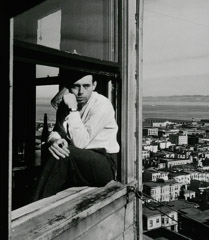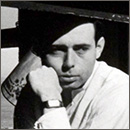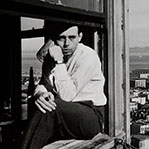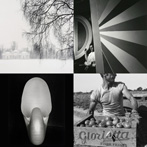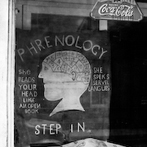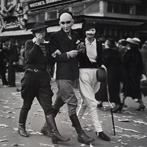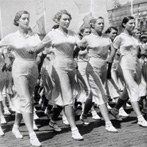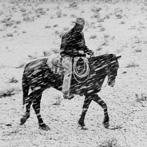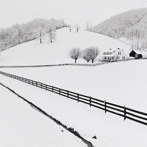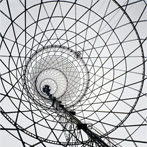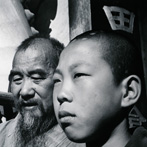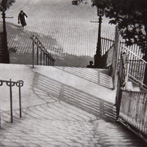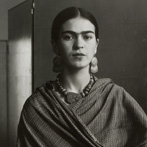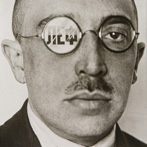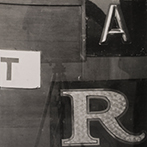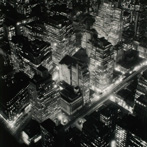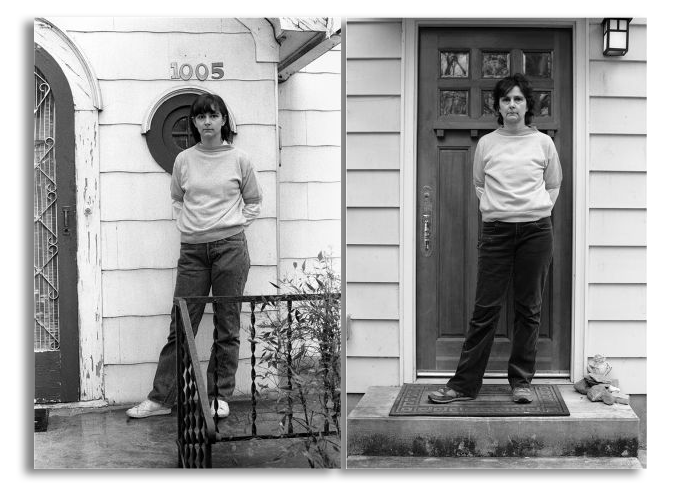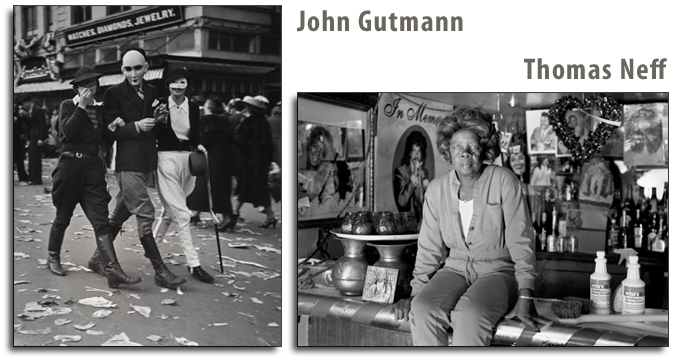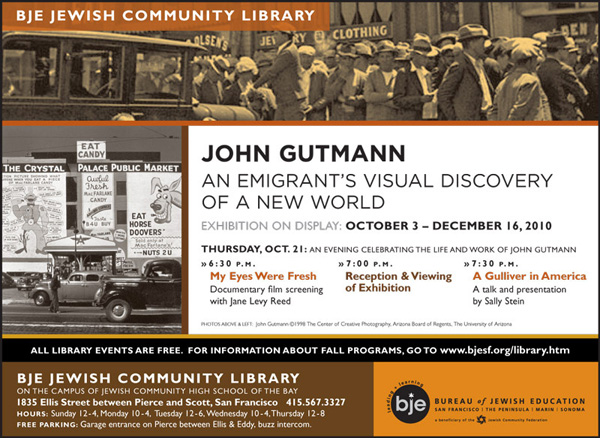John Gutmann
John Gutmann (1905-1998)
Born in Breslau, Germany, Gutmann studied to be a painter under Otto Mueller before turning to photography shortly before he emigrated to the United States, where he became known for his vivid images of popular culture. Gutmann brought a foreigner’s view to the streets of California, where he saw with fresh eyes such astonishing (to him) phenomena as multiracial crowds, drive in movies and restaurants, drum majorettes, car parks and golf links, beauty contests, tattoo parlors, and movie marquees. He was fascinated by the status of the car as an American icon and photographed unusual license plates, decorated dashboards, decals, and hood ornaments. He also took a notable series of New York City in the 1940s. In Germany he worked as a photojournalist for Presse Photo before his arrival in the United States, when he worked as a photojournalist for Pix, Inc. (1936 1963). A professor at San Francisco State University from 1938 to 1973, Gutmann won a Guggenheim fellowship in 1978. His work has been published in major periodicals and is held by such collections as those of the Amon Carter in Fort Worth, San Francisco’s Museum of Modern Art, and the Seagram Collection in New York.
![]()
The work of John Gutmann is featured in these exhibitions.
(Select the image to view the exhibition page)
The work of John Gutmann is featured in these Theme Collections.
(Select the image to view the theme page)
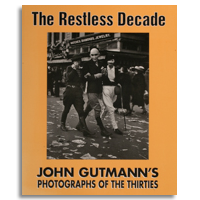
The Restless Decade
Published 1996
Publisher: Harry N. Abrams Inc.
ISBN 0-8109-2695-4 (pbk.)
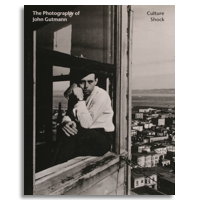
The Photography of John Gutmann: Culture Shock
Published 2000
Publisher: Merrell Publishers
ISBN 0-85894-097-4
Culture Shock @ The Breman Museum
Previous Exhibition
Culture Shock focused on an early period of creative flowering for the Jewish photographer, a German refugee who arrived in the U.S. during the Great Depression. The exhibition showcased over 60 revealing images of American popular culture that Gutmann captured as only an outsider could.
The exhibition: Culture Shock, featured the work of John Gutmann, An archive of the exhibition can be found at THIS LINK.
Presentation by Jane Levy Reed
Below is the presentation delivered at the Breman Museum on October 2, 2022, by filmmaker Jane Levy Reed. Reed a close personal friend of Gutmann, shared her insights and knowledge of the artist.
John Gutmann Fellowship Awarded to Nancy Floyd and McNair Evans
January 12, 2015
SAN FRANCISCO – The San Francisco Foundation announced today that McNair Evans of San Francisco, CA and Nancy Floyd of Atlanta, GA are the winners of the 2014 John Gutmann Photography Fellowship, an annual award given to up to two emerging artists who exhibit professional accomplishment, serious artistic commitment, and need in the field of creative photography. – Read the complete press release.
The prestigious award, established by the late photographer John Gutmann (1905-1998) at The San Francisco Foundation, brings with it $5,000 to each awardee to support the development of their creative work. Eminent photographers and curators Richard Misrach, Sandra S. Phillips, and Leland Rice were this year’s jurors. – More information on the John Gutmann Fellowship.
Lumière is proud to present the work of John Gutmann, more information and images can be found on his artist page.
Image Above: Weathering Time: 1982/2012, courtesy Nancy Floyd
Mardi Gras Remembrance
March 4, 2014
With Mardi Gras festivities earlier this week, we would like to feature the work of two photographers. Their work, although separated by 68 years, displays a vitality and uniqueness that can only be found in New Orleans.
In 1937 John Gutmann traveled from his newly adopted home in San Francisco to record the 1937 Mardi Gras celebration. On this trip he also traveled through Alabama, rural Georgia and Atlanta, specifically Spelman College. View Gutmann’s artist page for additional images.
Also unique to New Orleans is the post Katrina portraiture of Thomas Neff. The image shown here is of Antoinette K-Doe, owner and operator of Mother-in-Law Lounge, in the Treme neighborhood of New Orleans. Mrs. K-Doe rode out the storm and defended the lounge through the “lawless” period that followed the levee breaks. Unfortunately, five years ago, Ms. K-Doe passed away on Mardi Gras, February 24, 2009 (NY Times obit). Addition work by Neff including more from the Katrina project can be found on his artist page.
John Gutmann: My Eyes Were Fresh
Gutmann’s work and life story are both remarkable. As a young man he studied painting in the late 20’s under Otto Mueller. With the rise of the Nazi’s he leaves Germany in 1933, and begins his photographic career in San Francisco, which remained his home the rest of his life. Working as a photojournalist through the depression years Gutmann’s keen visual eye trained on the streets of his new adoptive home results in a spectacular body of work.
The video to the right, begins with Gutmann in a gallery discussing one of his common themes, the American fascination with the automobile.
Lumière was proud to feature Gutmann’s work in our exhibition – My Eyes Were Fresh.
Additional images and biographic information can also be found on his artist page.
John Gutmann - at the BJE Library in San Francisco
The work of photographer John Gutmann was featured in an exhibition at the BJE Jewish Community Library in San Francisco in 2010. An Evening Celebrating the Life and Work of John Gutmann, included the screening of Jane Levy Reed’s outstanding documentary entitled My Eyes Were Fresh, along with a talk and presentation by Sally Stein entitled A Gulliver in America.
An exhibition of sixty six photographs by John Gutmann’s was previously shown at Lumière, select to view the exhibition or to view additional images by Gutmann visit his artist page.
John Gutmann: My Eyes Were Fresh - Film Screening and Panel Discussion
April 6, 2008
Atlanta History Center
A unique film and lecture on the perspective of John Gutmann by filmmaker and independent photography curator Jane Levy Reed. Gutmann a German intellectual, formally trained in painting, fled Nazi Germany to begin his artistic career as a photographer in San Francisco with a European perspective on depression era America. The screening was followed by audience discussion with a panel including: Ellen Fleurov, President, Crossroads Traveling Exhibitions and former Curator of Photography, High Museum of Art, and Sylvia Naguib, Museum Curator, Jimmy Carter Presidential Library and Museum.
AJC, A European Eye Trained On American Depression
Below is an excerpt of a review from the Atlanta Journal and Constitution.
To read the entire review please access the AJC web site.
DATE: April 6, 2008
PUBLICATION: Atlanta Journal-Constitution
BYLINE: Lisa Kurzner
TITLE: A European Eye Trained On American Depression
EXHIBITION: John Gutmann: My Eyes Were Fresh
Bottom line: This photography show takes viewers through 1930s America through the eyes of an accomplished European modernist. Not to be missed. The John Gutmann show at Lumiere gallery lets viewers tour city life of 1930s America through European eyes, bringing a modernist flair and incisive vision to a nation grappling with the Depression and readying for war. Gutmann, born in Germany and trained in Berlin in Expressionist Otto Mueller’s studio, left for San Francisco in 1933 as the Nazis came to power.
Though trained as a painter, Gutmann was photographing for picture agencies before his trans-Atlantic move. One of the few European images in the show, “October Berlin” (1933), of a girl and her reflection caught in a shop window, reveals the compositional assurance of photographers such as Andre Kertesz and Man Ray in Gutmann’s work. “Elevator Garage, Chicago” (1936) turns the vertical automobile garage into a column of Bauhaus might and sets it against one of the city’s fabled skyscrapers.
The exhibition of almost 80 silver prints ranges broadly from images of commercial signage and graffiti to a sequence on the American car photographed around the country. In between are arresting images from New Orleans’ Mardi Gras to New York’s Bowery and the down and out in Mobile.
Most fascinating are the images of military presence on U.S. shores, whether in parade formation or patrolling San Francisco streets during its 1934 general strike. Having only recently left Germany, Gutmann undoubtedly was sensitive to the notion of military control in society.
Stylistically, Gutmann, like the Surrealists and modern painters of the era, was interested in anonymous folk art culture, as seen in the sign images, layered from foreground to background with hand lettering.
“Ben’s Barbershop Window” (1946), a storefront display filled with haphazardly arranged signs, echoes Walker Evans’ “American Photographs” work of the 1930s and exemplifies Gutmann’s finely tuned pictorial sensibility. The play of light and shadow brings the signage to life, both the messages and writers behind them.
The prints were produced by Gutmann primarily in the 1980s, following his rediscovery as appreciation for photography expanded in museum culture. Although vintage work by Gutmann exists, it is rare, and this show presents collectors and enthusiasts with a significant body of work to learn about this accomplished photographer.
It’s a wonderful gem of a show.



